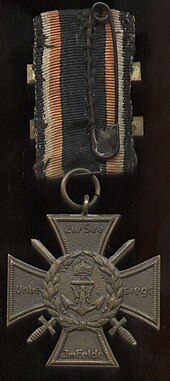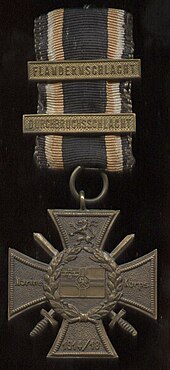Flanders Cross

The Flanders Cross or "Cross of Honor and Remembrance of the Marine Corps Flanders" is a non-state German World War II commemorative award from the time of the Weimar Republic .
prehistory
On August 23, 1914, the German Supreme Army Command decided to found a Flemish expedition corps from marines. Due to the course of the war on the Western Front , it soon became apparent that marine infantry had to support the field army on a permanent basis. Therefore the Marine Corps Flanders was formed . In November 1914 it consisted of two naval divisions, and in June 1917 a third was added. The troops proved themselves over the entire world war in sometimes very hard fights. The commander of the "Marine Corps Flanders" was Admiral Ludwig von Schröder , who was known as the Lion of Flanders .
Foundation and award
On September 13, 1921, Admiral Ludwig von Schröder and the Comradeship Association of the "Marine Corps Flanders" donated the "Cross of Honor and Remembrance of the Marine Corps Flanders", known as the "Flanders Cross", as a mark of honor and commemoration for the war battles that had just been overcome.
All World War II participants who had belonged to the "Marine Corps Flanders" and were in possession of their civil rights were entitled to wear it. In the foundation statutes it says u. a .:
“In the days of September 1914, the newly established naval division - later the Marine Corps - received the baptism of fire in a victorious battle against the Belgian army, near Löwen and Kampenhout north of Brussels , in a five-day battle and then distinguished itself in many battles in the more than four-year world war. In memory of this time in which the Marine Corps has always proven itself honorable and glorious on land, on water, in the air and under water, the Cross of Honor and Commemoration of the Marine Corps for former members of the To be dedicated to the corps: to commemorate fallen comrades, the fighters of the corps to acknowledge their faithfully fulfilled duty and bravery in the war of 1914/18 and to warn the German people and their descendants. "
Appearance
The one-step award is a patinated bronze cross with a support ring for the ribbon. It has the shape and design of the Iron Cross, but with 2 swords that run crossed through the center. The cross has a length and width of 4 cm.
front
In the center the Reich War Flag (model 1903-21), framed by a laurel wreath. Above, on the upper arm of the cross, the Flemish lion - probably also an allusion to the founder, the “Lion of Flanders”. On the two horizontal arms of the cross the inscription (left) Marine ; (right) corps ; on the lower arm of the cross the year 1914/18 .
back
In the center the emblem of the Imperial Navy (anchor crowned with the imperial crown and the cipher W for Wilhelm), surrounded by a laurel wreath. On the arms of the cross the inscription (above) Zur See ; (below) In the field ; (left) unconventional ; (right) wins .
Carrying method
The award was worn on a 2.8 cm wide, black ribbon with two black / white / red longitudinal edges (each color of the edge strip 2.5 mm) on the left side of the chest.
Combat clips

Battle clips could be attached to the tape if there was evidence of participation in battles or combat operations (pay book).
Known are the battle clasps (gold-colored metal plaques with raised, narrow frames and inscriptions on a grained background):
- Battle of Flanders
- Battle of Flanders (1917)
- Breakthrough battle
- Ypres
- Yser
- Somme
- Antwerp
- Naval warfare
- Air war
Special
About 30,000 crosses were awarded after a commission set up by Admiral von Schröder had examined the respective award requirements. The badge of honor had to be procured at one's own expense, it cost 3.50 M, the miniature 2 M and each battle clasp 50 Pfg. The award certificates show the typical Flemish bell tower, a " belfry ", in the sunshine.
For various political reasons, the establishment of an official commemorative symbol of the World War was not established in the German Reich, whereas most other states (including those on the losing side) created corresponding decorations. This created a strong vacuum in Germany, as German war veterans wanted such a badge of honor.
Numerous smaller and larger associations filled this gap with private endowments of World War I honors and memorials, including the Flanders Cross.
Often these awards are more dignified and magnificent - because they are paid for themselves - than a state commemorative symbol could ever have been. All these unofficial World War Medals were banned with the foundation of the (rather modest and only one-sidedly embossed) State Cross of Honor of the World War , 1934/35. At this point in time at the latest, they were no longer awarded, and no further wearing was permitted. In fact, however, they were often passed on with tacit tolerance alongside the official medals and decorations.
literature
- Ludwig Arndt: Military associations in Northern Germany: Club life, badges, awards, monuments. Books on Demand, 2008, ISBN 978-3-8334-8966-2 .
